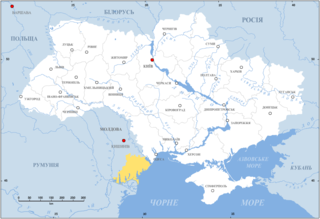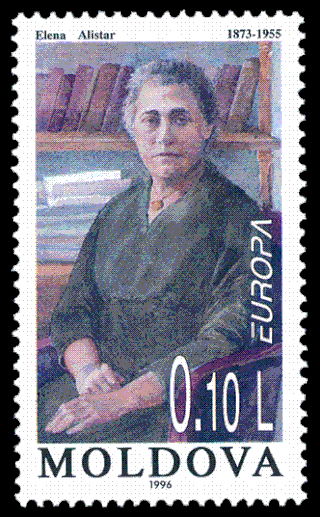
Bessarabia is a historical region in Eastern Europe, bounded by the Dniester river on the east and the Prut river on the west. About two thirds of Bessarabia lies within modern-day Moldova, with the Ukrainian Budjak region covering the southern coastal region and part of the Ukrainian Chernivtsi Oblast covering a small area in the north.

Bukovina is a historical region, variously described as part of either Central or Eastern Europe. The region is located on the northern slopes of the central Eastern Carpathians and the adjoining plains, today divided between Romania and Ukraine.

Chernivtsi Oblast, also referred to as Chernivechchyna (Чернівеччина), is an oblast (province) in western Ukraine, consisting of the northern parts of the historical regions of Bukovina and Bessarabia. It has an international border with Romania and Moldova. The region spans 8,100 square kilometres (3,100 sq mi). The oblast is the smallest in Ukraine both by area and population. It has a population of 890,457, and its administrative center is the city of Chernivtsi.

Hertsa Raion or Hertza Raion was an administrative raion (district) in the southern part of Chernivtsi Oblast in western Ukraine, on the Romanian border. The region had an area of 308.7 square kilometres (119.2 sq mi) and the administrative center in the city of Hertsa. It was one of the three raions of Ukraine with the majority of ethnic Romanian population. The raion was abolished on 18 July 2020 as part of the administrative reform of Ukraine, which reduced the number of raions of Chernivtsi Oblast to three. The area of Hertsa Raion was merged into Chernivtsi Raion. The last estimate of the raion population was 33,175

Budjak, also known as Budzhak, is a historical region that was part of Bessarabia from 1812 - 1940. Situated along the Black Sea, between the Danube and Dniester rivers, this multi-ethnic region covers an area of 13,188 km2 (5,092 sq mi) and is home to approximately 600,000 people. The majority of the region is now located in Ukraine's Odesa Oblast, while the remaining part is found in the southern districts of Moldova. The region is bordered to the north by the rest of Moldova, to the west and south by Romania, and to the east by the Black Sea and the rest of Ukraine.

Moldovans, sometimes referred to as Moldavians, are a Romanian-speaking ethnic group, nation and the largest ethnic group of the Republic of Moldova and a significant minority in Ukraine and Russia. There is an ongoing controversy, in part involving the linguisitic definition of ethnicity, over whether Moldovans' self-identification constitutes an ethnic group distinct and separate from Romanians, or a subset. The extent of self-identification as Romanians in the Republic of Moldova varies.

The Hertsa region, also known as the Hertza region, is a region around the town of Hertsa within Chernivtsi Raion in the southern part of Chernivtsi Oblast in southwestern Ukraine, near the border with Romania. With an area of around 304 km2 (117 sq mi), it has a population of about 32,300 people, 93% of whom are ethnic Romanians.

Moldovenism is a political term used to refer to the support and promotion of the Moldovan identity and Moldovan culture primarily by the opponents of such ideas.

Hotin County was a county in the Principality of Moldavia (1359–1812), the Governorate of Bessarabia (1812–1917), the Moldavian Democratic Republic (1917–1918), and the Kingdom of Romania.

This article represents an overview on the history of Romanians in Ukraine, including those Romanians of Northern Bukovina, Zakarpattia, the Hertsa region, and Budjak in Odesa Oblast, but also those Romanophones in the territory between the Dniester River and the Southern Buh River, who traditionally have not inhabited any Romanian state, but have been an integral part of the history of modern Ukraine, and are considered natives to the area. There is an ongoing controversy whether self-identified Moldovans are part of the larger Romanian ethnic group or a separate ethnicity.

This is the history of Transnistria, officially the Pridnestrovian Moldavian Republic (PMR), an unrecognised breakaway state that is internationally recognised as part of Moldova. Transnistria controls most of the narrow strip of land between the Dniester river and the Moldovan–Ukrainian border, as well as some land on the other side of the river's bank.

The Metropolis of Chișinău and All Moldova, also referred to as the Moldovan Orthodox Church, is an autonomous metropolitanate under the Russian Orthodox Church. Its canonical territory is the Republic of Moldova.

Novoselytsia Raion was a raion in Chernivtsi Oblast, (province) in the west of Ukraine. The western part of its territory lied in the historical region of Bukovina, the eastern part in Bessarabia, while one village (Boianivka) was part of the Hertsa region. The center of the raion was the city of Novoselytsia. The raion was abolished on 18 July 2020 as part of the administrative reform of Ukraine, which reduced the number of raions of Chernivtsi Oblast to three. The area of Novoselytsia Raion was split between Chernivtsi and Dnistrovskyi Raions. The last estimate of the raion population was 76,744
Anti-Romanian sentiment, also known as Romanophobia is hostility, hatred towards, or prejudice against Romanians as an ethnic, linguistic, religious, or perceived ethnic group, and it can range from personal feelings of hatred to institutionalized, violent persecution.

Moldova–Russia relations are the bilateral relations between the Republic of Moldova and the Russian Federation, two Eastern European, post-Soviet, ex-communist countries. Russian support for the self-proclaimed Pridnestrovian Moldavian Republic (Transnistria) and a substantial Russian military presence therein strained Moldovan relations with Russia.
The union of Bessarabia with Romania was proclaimed on April 9 [O.S. March 27] 1918 by Sfatul Țării, the legislative body of the Moldavian Democratic Republic. This state had the same borders of the region of Bessarabia, which was annexed by the Russian Empire following the Treaty of Bucharest of 1812 and organized first as an Oblast and later as a Governorate. Under Russian rule, many of the native Tatars were expelled from parts of Bessarabia and replaced with Moldavians, Wallachians, Bulgarians, Ukrainians, Greeks, Russians, Lipovans, Cossacks, Gagauzes and other peoples, although colonization was not limited to formerly Tatar-inhabited lands. Russia also tried to integrate the region by imposing the Russian language in administration and restricting education in other languages.

The Bessarabia Governorate was a province (guberniya) of the Russian Empire, with its administrative centre in Kishinev. It consisted of an area of 45,632.42 square kilometres (17,618.78 sq mi) and a population of 1,935,412 inhabitants. The Bessarabia Governorate bordered the Podolia Governorate to the north, the Kherson Governorate to the east, the Black Sea to the south, Romania to the west, and Austria to the northwest. It roughly corresponds to what is now most of Moldova and some parts of Chernivtsi and Odesa Oblasts of Ukraine.

A controversy exists over the national identity and name of the native language of the main ethnic group in Moldova. The issue more frequently disputed is whether Moldovans constitute a subgroup of Romanians or a separate ethnic group. While there is wide agreement about the existence of a common language, the controversy persists about the use of the term "Moldovan language" in certain political contexts.

Elena Alistar-Romanescu was a Bessarabian physician and politician who was part of Sfatul Țării from Bessarabia.

Greater Moldova or Greater Moldavia is an irredentist concept today used for the credence that the Republic of Moldova should be expanded with lands that used to belong to the Principality of Moldavia or were once inside its political orbit. Historically, it also meant the unification of the lands of the former principality under either Romania or the Soviet Union. Territories cited in such proposals always include Western Moldavia and the whole of Bessarabia, as well as Bukovina and the Hertsa region; some versions also feature parts of Transylvania, while still others include areas of Podolia, or Pokuttia in its entirety. In its most post-Soviet iterations, "Greater Moldova" is associated with a belief that Moldovans are a distinct people from Romanians, and that they inhabit parts of Romania and Ukraine. It is a marginal position within the Moldovan identity disputes, corresponding to radical forms of an ideology polemically known as "Moldovenism".


















